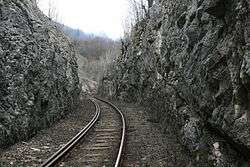Oravița
Oravița (Romanian pronunciation: [oˈravit͡sa]; Hungarian: Oravicabánya; German: Orawitz; Czech: Oravice; Serbo-Croatian: Oravica/Оравица) is a town in the Banat region of Romania, in Caraș-Severin County, with a population of 15,524 in 2000. Its theater is a fully functional scaled down version of the old Burgtheater in Vienna. Six villages are administered by the town: Agadici (Agadics; Agaditsch), Brădișoru de Jos (Majdán), Broșteni (Brostyán), Ciclova Montană (Csiklóbánya; Montan-Tschiklowa), Marila (Marillavölgy; Marillathal) and Răchitova (Rakitova).
| Historical population | ||
|---|---|---|
| Year | Pop. | ±% |
| 1930 | 9,585 | — |
| 1948 | 6,974 | −27.2% |
| 1956 | 8,175 | +17.2% |
| 1966 | 9,912 | +21.2% |
| 1977 | 14,987 | +51.2% |
| 1992 | 15,293 | +2.0% |
| 2002 | 15,222 | −0.5% |
| 2011 | 10,225 | −32.8% |
| Source: Census data | ||
Oravița | |
|---|---|
 Coat of arms | |
 Location in Caraș-Severin County | |
 Oravița Location in Romania | |
| Coordinates: 45°2′25″N 21°41′7″E | |
| Country | |
| County | Caraș-Severin |
| Government | |
| • Mayor | Dumitru Ursu[1] (PSD) |
| Area | 162.64 km2 (62.80 sq mi) |
| Population (2011)[2] | 11,382 |
| • Density | 70/km2 (180/sq mi) |
| Time zone | EET/EEST (UTC+2/+3) |
| Vehicle reg. | CS |
| Website | www |
Etymology
The name of the town is derived from the Slavic word orah(ov), meaning "(of) walnut" with suffix -ița.[3]
Villages
Agadici
The history of Agadici can be traced back to at least the 17th century, when records noted a population of "800 souls". Today, there are fewer than 200 people living in Agadici. Agadici is a word derived from Turkish: Aga meaning 'colonel' and dici meaning 'daughter'. Therefore, Agadici means "daughter of the colonel". The town was supposedly named after a colonel's daughter when the Ottoman Empire occupied the land that is now the Banat (see the Temeşvar Eyalet).
Ciclova Montană
The second-oldest beer in what is now Romania was produced in Ciclova; it is first attested in a document of 1728. In the beginning, production was under the management and patronage of the local Catholic monastery. Known as "bere Ciclova" in later years, the firm went bankrupt in 1996.[4]
Anina–Oravița railway

The Anina–Oravița was the first mountain railway in today's Romania, opened in 1863, it is still in use today for touristic purposes, and it is one of the most beautiful railways in Europe due to very picturesque landscapes, viaducts and long tunnels.
References
| Wikivoyage has a travel guide for Oravița. |
| Wikimedia Commons has media related to Oravița. |
- "Results of the 2016 local elections". Central Electoral Bureau. Retrieved 3 April 2020.
- "Populaţia stabilă pe judeţe, municipii, oraşe şi localităti componenete la RPL_2011" (in Romanian). National Institute of Statistics. Retrieved 4 February 2014.
- Iordan, Iorgu (1963). Toponimia romînească. Bucharest: Editura Academiei Republicii Populare Romîne. p. 84. OCLC 460710897.
- (in Romanian) Cristian Franț, "Berea Ciclova, un brand extrem de puternic care a murit subit", Adevărul, June 24, 2013
